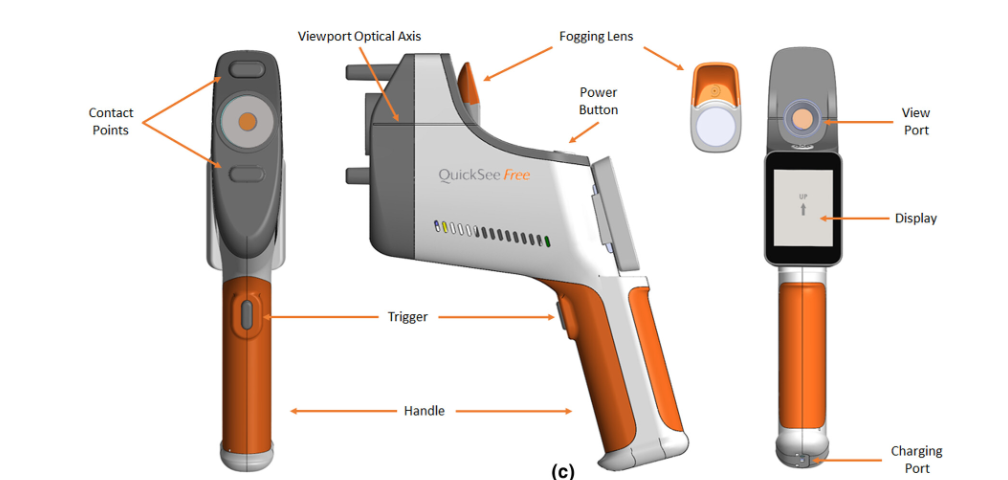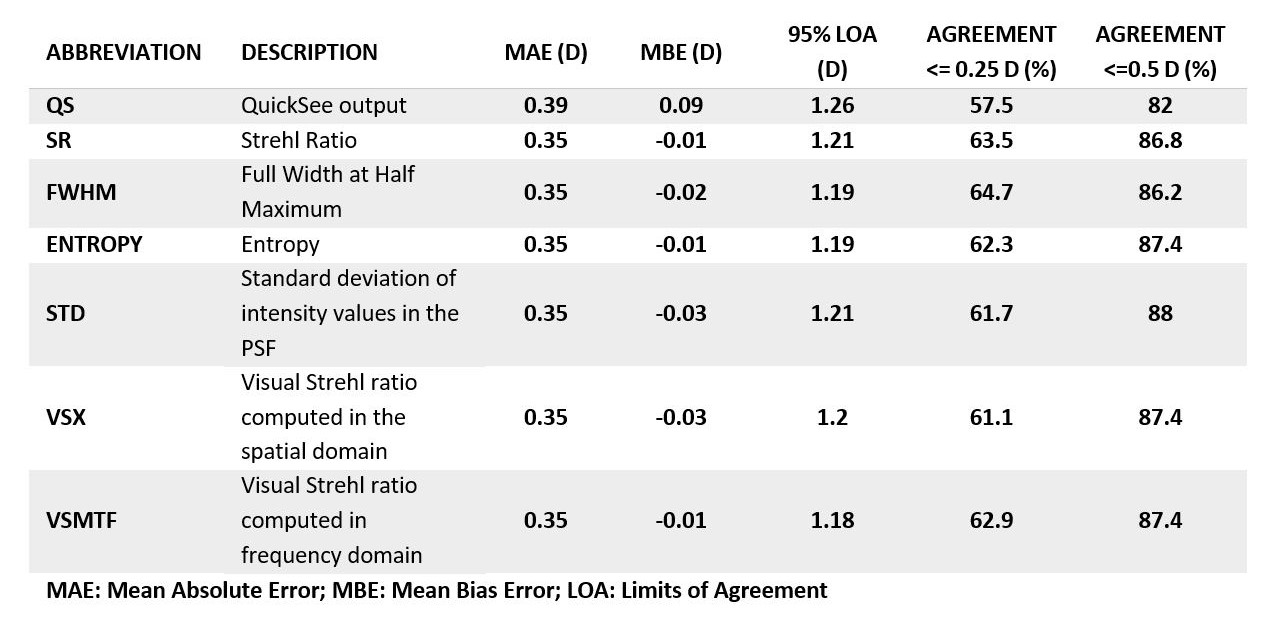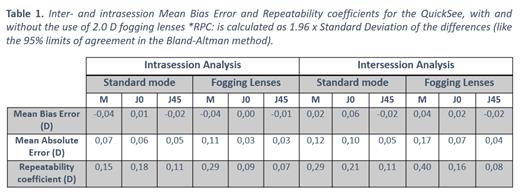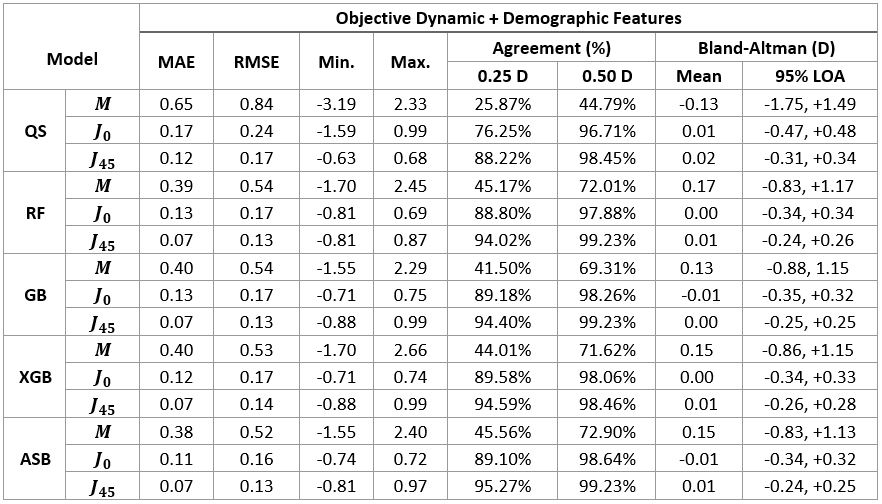| AUTHORS | |
| JOURNAL | Ophthalmic and Physiological Optics |
| ABSTRACT |
AbstractIntroductionDespite the well-known reproducibility issues of subjective refraction, most studies evaluating autorefractors compared differences between the device and subjective refraction. This work evaluated the performance of a novel handheld Hartmann–Shack-based autorefractor using an alternative protocol, which considered the inherent variability of subjective refraction. MethodsParticipants underwent an initial measurement with a desktop autorefractor, two subjective refractions (SR1 and SR2) and a final measurement with the QuickSee Free (QSFree) portable autorefractor. Autorefractor performance was evaluated by comparing the differences between the QSFree and each of the subjective refractions with the difference between the subjective refractions (SR1 vs. SR2) using Bland–Altman analysis and percentage of agreement. ResultsA total of 75 subjects (53 ± 14 years) were enrolled in the study. The average difference in the absolute spherical equivalent (M) between the QSFree and the SR1 and SR2 was ±0.24 and ±0.02 D, respectively, that is, very similar or smaller than the SR1 versus SR2 difference (±0.26 D). Average differences in astigmatic components were found to be negligible. The results demonstrate that differences between QSFree and both subjective refractions in J0 and J45 were within ±0.50 D for at least 96% of the measurements. The limits of agreement (LOAs) of the differences between QSFree and SR1, as well as QSFree and SR2, were higher than those observed between SR1 and SR2 for M, J0 and J45. ConclusionsA protocol was designed and validated for the evaluation of a refractive device to account for the variability of subjective refraction. This protocol was used to evaluate a novel portable autorefractor and observed a smaller difference between the device and subjective refractions than the difference between the two subjective refraction measurements in terms of mean bias error, although the standard deviation was higher.
|
| LINK | here |
Year: 2023
| AUTHORS |
Andrea Gil Ruiz
Carlos Santiago Hernandez Torres
Ignacio Casares
Jesus Poderoso
Daryl Lim
Shivang Dave
Eduardo Lage Negro
|
| JOURNAL | ARVO |
| ABSTRACT |
PurposeModern autorefractors have demonstrated high accuracy and higher repeatability than manifest refraction in adults yet are not considered precise enough to substitute the gold standard, even in low-resource settings where there is a severe shortage of experienced refractionists. This work evaluates a novel approach that combines dynamic wavefront aberrometry data, acquired using an affordable portable autorefractor, with the analysis of retinal image quality metrics (IQMs) to predict subjective refraction. Methods56 subjects (34±14 years) were recruited for the analysis. Each participant underwent standard clinical refraction followed by a 10-second video acquisition using a QuickSee (QS) wavefront aberrometer (PlenOptika, USA). Shack-Hartmann images of each video for the right eye were processed to obtain Zernike coefficients up to the 4th order. Coefficients obtained for each image were mathematically corrected with the closest sphero-cylindrical correction and the residual wavefront error was used to calculate the Point Spread Function (PSF) and IQMs (e.g., Strehl Ratio) describing some performance parameter of the corrected eye. Since each IQM is part of a dynamic sequence, it is possible to build a dynamic signal for each metric which contains information about fluctuations in image quality during the measurement. The final refraction is obtained as the average of the refractions corresponding to the images whose IMQs provided optimal performance. ResultsThe proposed method reduced the differences between QS and manifest refraction. Specifically, for spherical equivalent refraction (M) (Table 1) a 79% average reduction in MBE together with moderate average improvements for MAE (10.3%), LOA (5%), and percentage of agreement within 0.25D (8.8%) and 0.5D (6.3%) were found for all IQMs evaluated. ConclusionsThe proposed algorithm behaves as an efficient filter which selects those measurements within the dynamic sequence that are more representative of the manifest refraction of the patient. |
| LINK | here |
| AUTHORS |
Eduardo Lage
Carlos Santiago Hernandez
Andrea Gil Ruiz
Ignacio Casares
Jesus Poderoso
Alec Wehse
Alfonso de Lara
Daryl Lim
Shivang Dave
|
| JOURNAL | ARVO |
| ABSTRACT |
PurposeHigh repeatability portable autorefractors may enable effective deploy of global-health initiatives to mitigate uncorrected refractive error worldwide. For example, in studies to evaluate the effectiveness of different measures, repeatability has a direct impact on the statistical power and sample size required, while in screening applications, contributes to increased sensitivity and specificity. This work presents a preliminary assessment of the inter- and intrasession repeatability of an affordable autorefractor (QuickSee, PlenOptika Inc) under two separate measurement conditions, with and without fogging lenses. Methods6 volunteers (29,8 ± 8,1 years old) were measured at 2 different sessions spaced 1-week. Each subject was tested 6 times per session with the QuickSee, 3 times in standard mode and 3 using a modified version of the device eyecup to allow over-refraction through fogging lenses (+2.0 D). Intersession measurements were spaced 5 minutes apart and the complete alignment procedure was repeated for each measurement. After converting autorefractor readings into power vectors (M, J0, J45), repeatability was evaluated using the Bland-Altman method to compare differences between all possible combinations from each subject (inter- and intrasession). Repeatability coefficients (RPC), estimated as the 95% limits of agreement, and the mean absolute errors were also evaluated. In all cases, only results for the right eyes were analyzed. ResultsParticipants had an average Spherical Equivalent (SE) refraction of -0.75 ± 2.06 D, (Min -5.11 D, Max 0.175 D). A total of 36 samples per dataset were obtained for the intrasession analysis while 54 samples per dataset were used in the intersession comparison. In all cases the mean difference was practically 0 indicating no bias for any of the vector components. SE RPCs for intrasession test were 0.15 D in standard mode and 0.29 D with the fogging lenses. Intersession RPCs were 0.29 D and 0.4 D without and with the fogging lenses, respectively. Detailed results for all vector components are shown in Table 1. ConclusionsThis preliminary analysis shows that the device can provide excellent RPCs in standard mode, which decrease moderately with the use of the fogging lenses. Further work exploring improvements in the eyecup design and measurement averaging techniques may further enhance the RPC values in over-refraction mode. |
| LINK | here |
| Funding Agency | Ministerio de Ciencia e Innovación, Govierno España |
| Principal Investigator/s | Eduardo Lage |
| Information | Type of Grant: Competitive funding , Spain
Grant code: TED2021-131541A-I00 Awardee Organization: MEDIC, UAM Project Start Date: 1-December-2022 Project End Date: 30-November-2024 Total Funding: 207.000 Euros MEDIC Personnel included in the grant / Role: Dr. Eduardo Lage — P. Investigator MsC Carlos Hernandez – Investigator MsC Andrea Gil — Investigator MsC Ignacio Casares — Engineer Eng. Alfonso De Lara — Engineer |
| AUTHORS |
Carlos Santiago Hernandez Torres
Andrea Gil Ruiz
Ignacio Casares
Jesus Poderoso
Alec Wehse
Shivang Dave
Daryl Lim
Manuel Sánchez Montañés
Eduardo Lage Negro
|
| JOURNAL | ARVO |
| ABSTRACT |
PurposeUncorrected Refractive Errors (UREs) is a reversible condition that can be treated with appropriate eyeglasses. UREs affect over 1 billion people globally, with 90% of this population living in low-and-middle-income countries where vision exams can be highly inaccessible due to a shortage of experienced eyecare professionals. This work aims to assess if a machine learning (ML) approach, when applied to data obtained with an affordable handheld autorefractor, could increase access to clinical-quality subjective refraction (SR) when operated by non-experts. MethodsData used for this analysis was obtained from a clinical study performed at Aravind Eye Hospital in Madurai, India, using a low-cost portable wavefront aberrometer, an early prototype of the QuickSee (QS) (PlenOptika, Inc., USA). A total of 669 participants were enrolled with ages ranging between 15 and 70 years (35.2 ± 13.7) and spherical equivalent error between -6.0 D and 3.5 D (-0.7 ± 1.67 D). Four ML regressor models were trained and tested for each power vector M, J0 and J45: random forest (RF), gradient boosting (GB), extreme gradient boosting (XGB), and a custom assembly model (ASB) that averages the predictions of RF, GB, and XGB. Algorithms were trained on a dataset of 1,244 samples using as input features: age, gender, Zernike coefficients up to 5th order, and measurement quality related metrics provided by the autorefractor. A smaller subset of 518 unseen samples was used to test the agreement of the predictions against SR using Bland-Altman analysis, overall prediction error in terms of mean absolute error (MAE) and root mean squared error (RMSE), and the percentage of agreement for 0.25 D and 0.5 D thresholds. ResultsAll models improved the agreement with SR compared to the baseline autorefraction, but ASB obtained the best results (Table 1). Bland-Altman analysis showed a decrease in the 95% limits of agreement of ±0.63 D, ±0.14 D, and ±0.08 D for M, J0 and J45, respectively. The wavefront-aberrometry related variables had the biggest impact on the prediction, while demographic and measurement quality-related features showed a heterogeneous but consistent predictive value. ConclusionsThese results suggest that ML is effective for improving precision in predicting patient’s SR from objective measurements taken with a low-cost portable device. |
| LINK | here |








